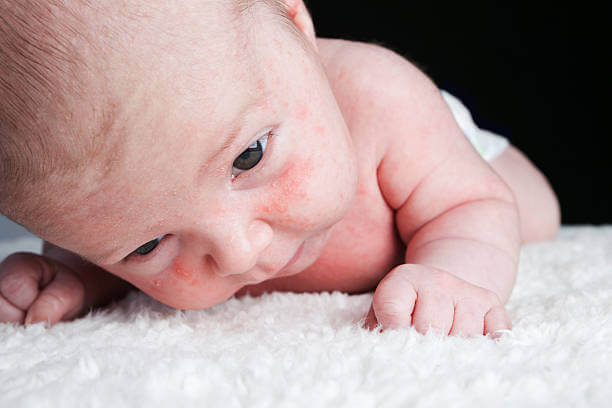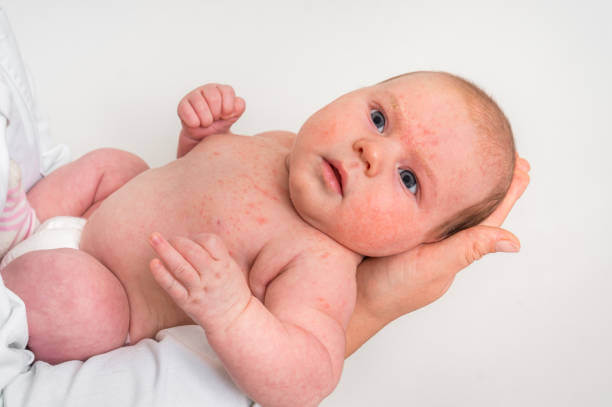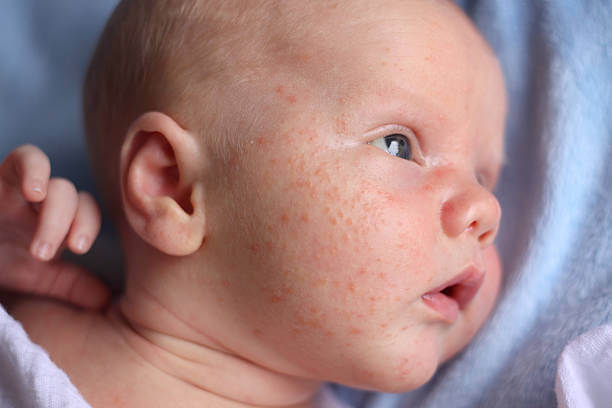Acne

Neonatal acne (acne neonatorum), also known as baby acne, is a skin condition that occurs in the first few weeks of life and can disappear on its own after a few weeks. Every fifth baby is affected by the typical small pimples on the forehead, cheek and chin.
The most important facts in brief:
Baby acne can occur in babies shortly after birth. These red pimples usually disappear by themselves after a few weeks. After four months at the latest, newborn acne has healed in most babies. Also, neonatal acne does not cause itching or pain, so children are not bothered by it. The face also becomes soft again after healing, no scars appear or remain.
Neonatal acne does not normally need to be treated. It disappears after a few weeks without leaving any scars. However, it sometimes happens that babies scratch the pimples, which causes the skin to become inflamed. This can also lead to bacterial inflammation. To prevent bacterial inflammation, it is advisable to spray SkinCare Acne on the affected areas.

Baby acne develops due to hormonal changes after birth. The cause of this is the male sex hormones (androgens). The mother transfers hormones to the child in the last phase of pregnancy. These hormones support the development of the immune system and the lungs.
The production of sebum is increased by androgens. This clogs the sebaceous glands. This leads to the development of baby acne. Androgens are broken down in the first few weeks of life.
This lowers the hormone level. The baby now produces its own hormones. Once the hormone level has settled at a normal level, the newborn acne also disappears.
Baby acne cannot be prevented. It has nothing to do with a lack of hygiene or poor nutrition. It is based exclusively on a hormonal change.
Baby acne can already occur at birth. However, it often only occurs in the third week of life.
The small pimples appear mainly on the face, forehead and cheeks, and in rare cases also on the chin. Newborn acne can also spread from the face to the chest and stomach.
The healing time is different for each baby. However, baby acne usually disappears within a few weeks. It disappears after four months at the latest.
The following symptoms occur with baby acne:

Neonatal acne is a harmless skin rash that occurs either at birth or in the first few weeks after birth.
The rash occurs mainly on the face, cheeks and forehead. Sometimes it also spreads to the chest and abdomen. In rare cases, baby acne is also found on the back.
It is not caused by a lack of hygiene or poor nutrition, but solely by the baby’s hormonal changes. Healing takes place without scarring, even in severe cases.
There is also no increased risk of acne in adolescence if you had neonatal acne as a baby. The situation is different with infant acne, however, where affected children are also more prone to acne later on.
Unlike neonatal acne, infant acne requires treatment. At first glance, it appears very similar to neonatal acne, but on closer inspection it is easy to distinguish. The main distinguishing features are the time of first appearance and the appearance of the pimples.
Infant acne develops between the third and sixth month of life and is characterized by red spots that are inflamed and cause itching. If the baby then starts scratching, scars can form.
Infant acne can also heal spontaneously, but usually persists longer than neonatal acne and can last until the age of 5, rarely even until puberty.
Infant acne is often a harbinger of severe acne in puberty as they develop it due to a genetic predisposition. Often the affected children are not the only family members who suffer from acne.
Author: Katharina Hillinger
“Our skin nourishes, detoxifies and protects our body. But in order for it to fulfill its functions, our skin flora must be in balance. Healthy skin is characterized by a diverse ecosystem of microbes that form a kind of protective shield.”
Share post: